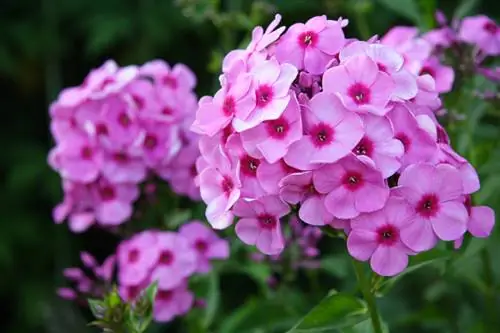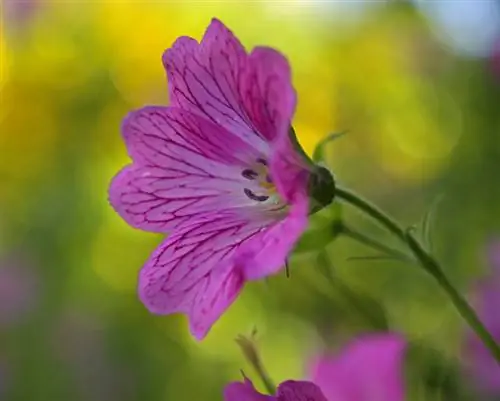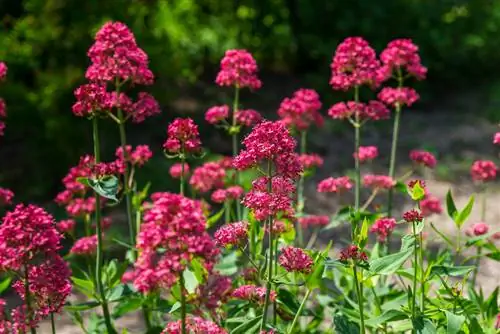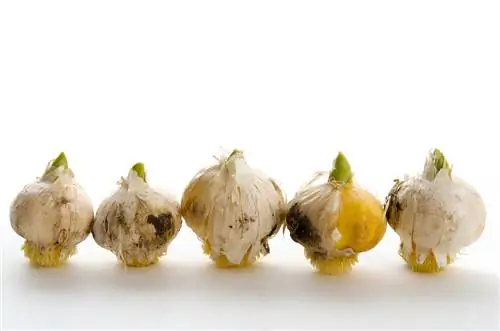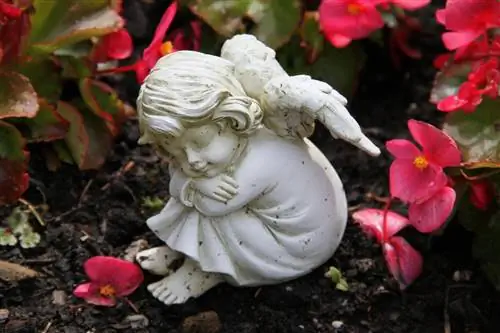- Author admin [email protected].
- Public 2023-12-25 17:45.
- Last modified 2025-01-23 11:22.
Expressive in appearance, Phlox transforms your midsummer garden into a fragrant sea of flowers. Browse here for compact answers to frequently asked questions about the magnificent phlox. This is how the planting and care of the decorative perennial proceed as desired.
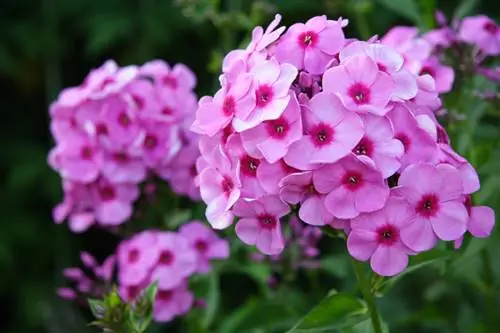
How do I care for and propagate Phlox successfully?
To achieve magnificent Phlox blossoms, you should choose a sunny to partially shaded location, water sufficiently, fertilize organically and remove wilted flowers. In spring and autumn you can propagate the plant by division or cuttings.
Planting phlox correctly
The flame flower has the potential to cover the summer garden with a fragrant sea of flowers for more than 10 years. With professional planting you lay the foundation for this respectable feat of strength. How to do it right:
- Soak the potted flower with water until no more air bubbles appear
- Weed the bed soil meticulously and rake it thoroughly
- Create small pits at a distance of 50-80 cm to optimize the excavation with compost
- Now unpot the flame flower and plant it exactly as deep as before in the growing pot
After you have watered the flower thoroughly, a nutritious layer of mulch promotes growth and flowering. In the pot and balcony box, insert a drainage made of potsherds or pebbles between the potting soil and the water drain to prevent waterlogging from forming.read more
Care tips
If you nurture and care for a flame flower, it will reward your attention with a long flowering period of up to 8 weeks and a lush subsequent bloom in pre-summer species. The following brief overview shows what the opulent flower really values:
- Keep the substrate constantly slightly moist without causing waterlogging
- Once budding begins, fertilize organically every 2 weeks until the end of the flowering period
- Early flowering varieties cut off close to the ground after the main flowering for subsequent flowering
- Cut off wilted flower spikes to prevent seed formation
- Completely cutting back the leaves only in early spring
If winter is approaching, wrap planters in bubble wrap and place them on a block of wood in front of the south wall of the house. If the bed is in a harsh winter region, we recommend protection in the form of leaves, straw or pine fronds, regardless of how hardy Phlox is to frost.
Which location is suitable?
The flower overall has a moderate character. This orientation is particularly evident in the choice of the ideal location. This is how the flame flower unfolds its beauty to perfection in sunny to partially shaded locations without direct sun. It prefers to spread its roots in slightly moist and nutrient-rich soil, as long as the soil is loose and well-drained.read more
The correct planting distance
The flame flower requires enough space to spread unhindered over the years. For the raised summer phlox, choose a planting distance of 50 to 80 cm and arrange no more than 3 to 5 specimens per square meter. For more delicate species, such as forest phlox, meadow phlox or upholstery phlox, adjust the distance to approx. 25 to 30 cm depending on the plant height.
What soil does the plant need?
Contributed to the popularity of the flame flower is its ability to thrive in any good garden soil. It should be fresh, moist, rich in nutrients and well-drained. Preferably slightly chalky and preferably not too sour. The sunnier the lighting conditions, the more moisture the soil should contain, whereas waterlogging is absolutely fatal for the summer flower. The flame flower creates eye-catching accents in pots and flower boxes if high-quality compost-based potting soil is chosen as the substrate.
What is the best time to plant?
The planting time for a phlox in a container is throughout the entire gardening season. As long as it doesn't freeze or there is sweltering summer heat, you can plant the flower in the ground. In order to create the best starting conditions for this lush perennial, we recommend planting from mid-May, when the risk of delayed ground frosts has passed.read more
When is flowering time?
With more than 70 species, the large Phlox family offers countless varieties. With the right combination, the beguilingly fragrant splendor of the phlox extends from early summer to the beginning of autumn. The most beautiful species and their central flowering period at a glance:
- Forest phlox: flowering period from April to May
- Cushion phlox: flowering period from May to June
- Meadow phlox: flowering period from the end of June to the beginning of August
- Summer phlox: flowering period from July to September
Clean out wilted flowers regularly to extend the length of the flowering period. Simply break off the spent panicles to make room for lush re-blooming. This effect is intensified if you shorten some summer phlox by a third in June.read more
Cut phlox correctly
A targeted cut at the right time is very important in the care of a phlox. Scissors are used on these occasions:
- Cut out or break out wilted flower spikes regularly
- In early summer, shorten half of the flower stems by a third for an extra long flowering period
- Pruning a flower close to the ground after the main bloom causes autumn blooms in early varieties
- Long-stemmed varieties of phlox are cut as decorative vase decorations
In autumn, cut off all withered flower spikes, but leave the leaves on the plant as additional winter protection until the next spring. Only before the new shoots do you cut off the retracted leaves of a flame flower close to the ground.read more
Watering Phlox
The phlox prefers an alternately moist substrate with intermediate drying phases. This claim implies that you always water when the surface of the soil has dried out. Due to the rain, this is less often necessary in the bed than in the pot or flower box. If you avoid watering under the blazing sun and do not sprinkle the flowers and leaves on the flower, the perennial will thank you for your care with a tireless abundance of flowers.
Fertilize Phlox properly
Fertilize the flame flower every 14 days when budding begins with an organic fertilizer such as compost, guano, bark humus or horn shavings. Long-term and complete mineral fertilizers carry the risk that the nitrogen they contain will encourage leaf growth while flowering will lag behind. For a flower in a planter, specialist retailers have organic liquid fertilizers available that are easy to administer.read more
Diseases
Although breeders are constantly producing new, particularly resistant varieties, the phlox in hobby gardens often suffers from mildew. This fungal infection can be recognized by a mealy, gray-white patina on the top and bottom of the leaves. Fresh milk has proven to be an effective home remedy in the early stages of infestation. Mix 100 ml of fresh milk (not UHT milk) into 900 ml of water and spray the infected flower repeatedly.read more
Wintering
With a few exceptions, all species and varieties of phlox are completely hardy. Only in particularly harsh regions do gardeners provide the perennial with the following winter protection:
- The foliage remains on the phlox until early spring
- Before the first frost, cover the perennial in the bed with straw, needles or leaves
- If there is a clear frost, water on mild days and do not fertilize
There is a risk of the root ball freezing in the pot and flower box. Small pots are therefore relocated to frost-free, not too dark winter quarters. Voluminous vessels with a diameter of more than 30 centimeters are wrapped in foil and placed on wood. Cover the substrate with pine fronds, wood wool or a layer of leaves.read more
Propagate Phlox
Once you've been captivated by the enchanting flame flower, you can't get enough of this magnificent flower. How good that propagation is possible in different ways:
- Dividing the root ball in spring or autumn
- Cutting non-flowering cuttings to root them in the pot
Sowing seeds, on the other hand, is not recommended as it is comparatively time-consuming and rarely successful. Since these are cold germinators, stratification is essential. In addition, the result usually leaves something to be desired, especially with seeds collected by hand.read more
Is phlox poisonous?
The flame flower contains no toxic ingredients. Therefore, the 2006 perennial is considered an ideal candidate for the family garden. The colorful petals are even suitable as a tasty and decorative ingredient for salads and cold dishes.read more
Phlox doesn't bloom
It is so devastating when the hoped-for flowering of a flame flower is delayed or fails completely. Don't throw in the towel straight away, because some of the most common causes of this problem can be remedied, as the following overview shows:
- Planted too deep: Dig up the flower and place it back in the ground no more than up to the root neck
- Drought stress: Always water phlox as soon as the substrate surface has dried
- Nutrient deficiency: Fertilize organically every 14 days from the start of budding until July
- Nitrogen excess: Do not administer nitrogen-rich complete fertilizer, which only makes the leaves grow
In addition, if you plant too early in the spring, there is a risk that the buds will freeze. If in doubt, cover the young plants with garden fleece overnight. If the ice saints have already struck, cut back the frozen shoots by a third in June so that the flower can sprout and bloom again.read more
How do I care for phlox after flowering?
When this year's blossom festival of a phlox is over, cut off the withered flower spikes. In this way, the flower saves its energy for next year's flowering and does not invest its energy in seed production. However, you can leave the leaves as long as the visual appearance of the garden does not suffer as a result. The retracted leaves act as natural winter protection and are preferably cut off close to the ground before the next shoots.
For species and varieties that bloom before summer, such as forest phlox or meadow phlox, cut the flower back to the ground after the main flowering and fertilize with compost. If the weather is suitable, you can look forward to autumnal blooms.read more
Beautiful varieties
- Clouds of Perfume: Light blue flowering forest phlox with early flowering from April; Growth height 40 cm
- David: White large-leaf phlox with a majestic silhouette; Growth height 100-120 cm
- Crackerjack: Dainty upholstery phlox for a crimson carpet of flowers in the bed; Growth height 5-10 cm
- Natasha; Bicolor phlox with white and pink striped flowers in July and August; Growth height 80 cm
- Argus: Late-blooming summer flower whose pink petals surround a red eye; Growth height 80-100 cm
- Blue Boy: Mid-late phlox, whose purple-blue flowers are decorated with white stars; Growth height 100 cm
- Capri: Very he althy, deep red blooming summer beauty from July to August; Growth height 100 cm

